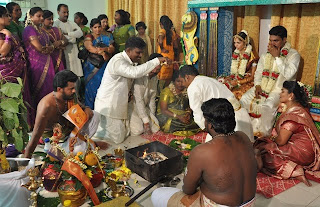
After the blessings and feeding the flame ceremonies...
... the couple sit on the dais. (The best-man has got out of the way.)

The parents on both sides bless each other by sprinkling 'rose water', placing the 'pottu' and the ladies placing jasmine flowers on the head. As Mani's parents are no longer here, the role was undertaken by his brother and sister and their spouses.

The priest then read out the marriage contract. I've always wondered about the information over-load in the Tamil section of wedding invitations. Now I know.


Both sides exchange the 'beetle leaf' tray. The difference between both sides, is the groom's side tray does not contain any money. (The money here is probably symbolic of the dowry that has been agreed upon.)

This exchange is followed by the groom's elders placing their right foot in a tray and the groom washing it, first with water, then milk followed by wiping it with a flower. He then places a 'pottu' on the feet.

The same rite is done by the bride to her parents.

The bride and groom return to the dais. The priest hands the 'thali' to the groom after blessing it.

The groom ties the 'thali' with the traditional three knots, signifying their bond in the 'three worlds'.

The groom's sister helps in tying the knots properly.

The groom then places the 'pottu' on the bride's forehead and the 'thali'.

He then places some jasmine flowers in her hair.

The 'pottu' ritual is repeated by the bride.























No comments:
Post a Comment